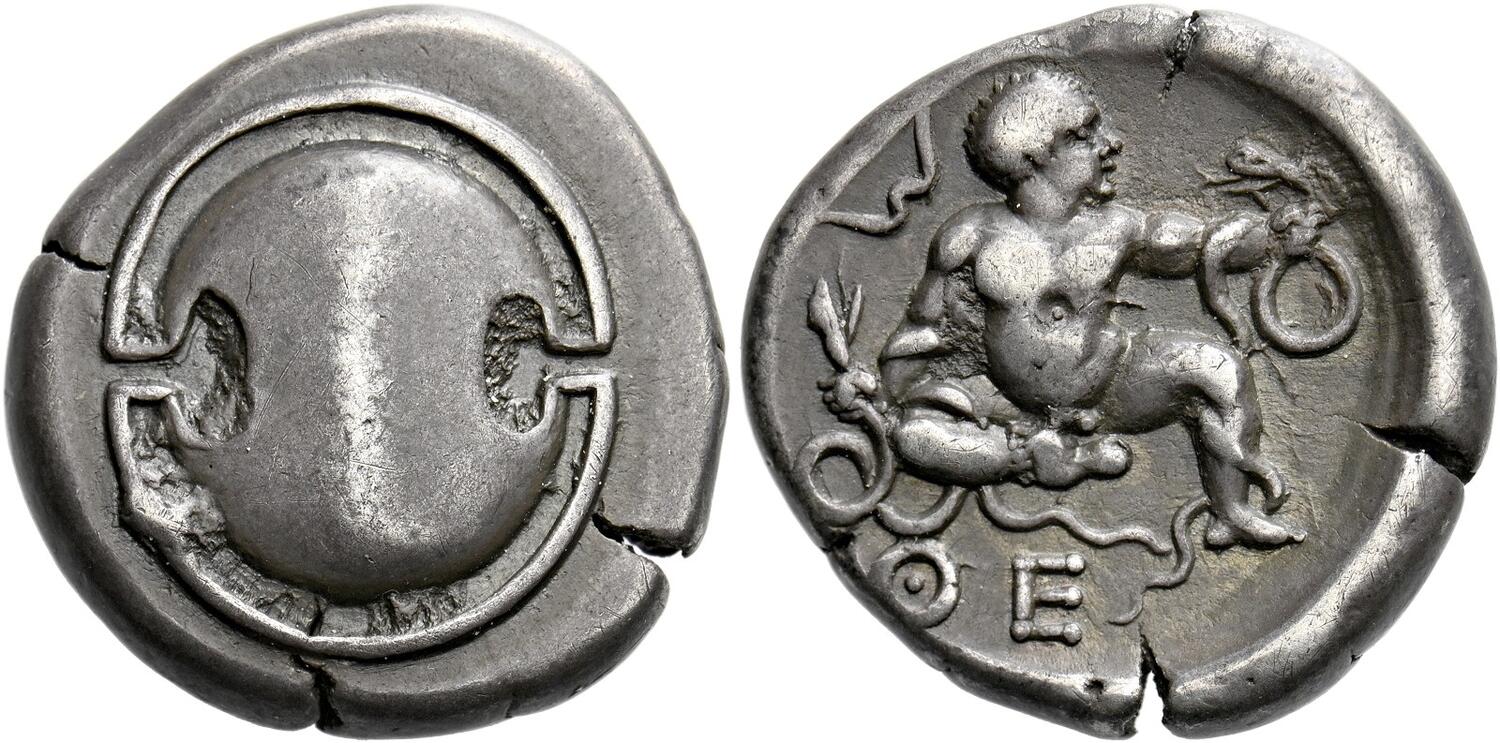AC 210 - Byzantium, Cnidus, Cyzikus, Ephesus, Iasus, Lampsacus, Rhodes and Samos, silver, stater, 395-387 BC
From SILVER
395 BCE - 387 BCE Silver 3,440 kg
Description
| ObverseInscription or printing placed on the obverse.: | Boeotian shield. |
| ReverseInscription or printing placed on the reverse.: | ΘE (Greek).ΘE Infant Heracles seated facing on ground, head right, strangling snake in each hand, bow in upper left field. |
Mint and issuing power
| MintIdentifies the place of manufacture or issue of a numismatic object.: | Byzantium; Cnidus | Ancient regionAncient region.: | Modern countryModern country: | AuthorityIdentifies the issuing power. The authority can be "pretended" when the name or the portrait of X is on the coin but he/she was not the issuing power. It can also be "uncertain" when there is no mention of X on the coin but he/she was the issuing power according to the historical sources: |
Chronology
| FromIdentifies the initial date in a range assigned in a numismatic context. | 395 BCE | toIdentifies the final date in a range assigned in a numismatic context.. | 387 BCE | PeriodTime period of the numismatic object.: Classical 480-323 BC |
Physical description
| MetalThe physical material (usually metal) from which an object is made.: | Silver |
Median weightMedian of the weights of numismatic objects (in grams). in grams | 10.90 | DenominationTerm indicating the value of a numismatic object. Examples: tetradrachm, chalkous, denarius.: | stater |
StandardStandard.: |
Image

AC210 Boeotia.jpeg [1]
References
| Die study referencePublication of the study: | Delrieux 20001Delrieux 2000, p. 185-211, pl. 31-4. | ||
| Coin series referenceReference to coin series study: | RQEMAC2RQEMAC, n° 210 | ||
Obverse dies distribution
| FrequencyFrequency of specimen in distribution. ᵖ | Number of obversesNumber of obverse dies. ᵖ (o) | % (o) | Number of coinsNumber of coins. (n) | % (n) | Die nameName(s) of the die(s). |
| 1 | 7 | 50 | 7 | 10.77 | 1(Byz), 1(Cyz), 4(Eph), 1(Ias), 2(Ias), 1(Lam), 2(Lam) |
| 2 | 2 | 14.29 | 4 | 6.15 | 2(Eph), 3(Eph) |
| 5 | 1 | 7.14 | 5 | 7.69 | 3(Cni) |
| 8 | 1 | 7.14 | 8 | 12.31 | 4(Cni) |
| 9 | 1 | 7.14 | 9 | 13.85 | 1(Sam) |
| 10 | 1 | 7.14 | 10 | 15.38 | 1(Eph) |
| 22 | 1 | 7.14 | 22 | 33.85 | 1(Rho) |
| Total | 14 of 14 | 99.99 | 65 of 65 | 100 |
Reverse dies distribution
no distribution is available
Quantification
| Number of obversesNumber of obverse dies. ᵖ (o) | 14 | Number of singletons (o1)The number of singleton coins. ᵖ | 7 |
| Number of reverse diesNumber of reverse dies. (r) | 12 | Number of coinsNumber of coins. (n) | 65 |
| Coins per obverse dieNumber of coins per obverse die. (n/o) | 4.64 | Coins per reverse dieNumber of coins per reverse die. (n/r) | 5.42 |
| Reverse per obverse ratioRatio of obverse dies divided by reverse dies. (r/o) | 0.86 | Percentage of singletons (o1)number of coins (n) divided by the number of singletons (o1) ᵖ | 50 % |
| Original number of dies (O) (Carter 1983 formula)The estimation of the number of coins according to Carter 1983 ᵖ | 15.78 | Coins struck if 20,000 as average productivity per dieCoins made if the average productivity for obverses (according to Carter) is 20,000. ᵖ | 315,600 |
| Original number of dies (O) (Esty 2011 formula)The estimation of the number of coins according to the singleton formula in Esty 2011 ᵖ (O) | 17.84 | Survival rate if 20,000 as average productivity per dieSurvival rate if average productivity is 20,000. ᵖ | 0.00021 |
| Coverage (o = % of O) (Esty 1984 formula)Esty 1984 - coverage (% of O) ᵖ (o = % of O) | 89.23% | Die productivity if survival rate 1/2,000Average productivity if survival rate is 1/2,000. ᵖ | 8,238.28 |
| Weight of silver (in kg) if 20,000 coins per die (O = Carter formula)Carter 1983 * Median weight * 20000 (*10 if gold or electrum) ᵖ | 3,440 kg <br /> 3,440 kg | Die productivity if survival rate 1/5,000Average productivity if survival rate is 1/5,000. ᵖ | 20,595.69 |
Remarks
References
- ^ Delrieux, Fabrice (2000), "Les ententes monétaires au type et à la légende ΣYN au début du IVe siècle", in Olivier Casabonne (ed.), Mécanismes et innovations monétaires dans l’Anatolie achéménide. Numismatique et histoire. Actes de la Table Ronde Internationale d’Istanbul, 22-23 mai 1997, Paris, p. 185-211, pl. 31-34.
- ^ Callataÿ, François de (2003), Recueil quantitatif des émissions monétaires archaïques et classiques, Numismatique Romaine, Wetteren, VII + 267 p.